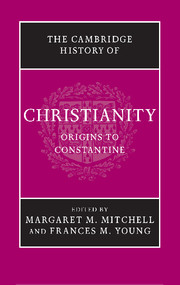Book contents
- Frontmatter
- Prelude: Jesus Christ, foundation of Christianity
- Part I The Political, Social and Religious Setting
- Part II The Jesus Movements
- Part III Community Traditions and Self-Definition
- Part IV Regional Varieties of Christianity in the First Three Centuries
- 15 From Jerusalem to the ends of the earth
- 16 Overview: the geographical spread of Christianity
- 17 Asia Minor and Achaea
- 18 Egypt
- 19 Syria and Mesopotamia
- 20 Gaul
- 21 North Africa
- 22 Rome
- Part V The Shaping of Christian Theology
- Part VI ‘Aliens’ become Citizens: towards Imperial Patronage
- Conclusion: retrospect and prospect
- Bibliographies
- Index
- Map 1. The Roman Empire in the time of Marcus Aurelius
- References
20 - Gaul
from Part IV - Regional Varieties of Christianity in the First Three Centuries
Published online by Cambridge University Press: 28 March 2008
- Frontmatter
- Prelude: Jesus Christ, foundation of Christianity
- Part I The Political, Social and Religious Setting
- Part II The Jesus Movements
- Part III Community Traditions and Self-Definition
- Part IV Regional Varieties of Christianity in the First Three Centuries
- 15 From Jerusalem to the ends of the earth
- 16 Overview: the geographical spread of Christianity
- 17 Asia Minor and Achaea
- 18 Egypt
- 19 Syria and Mesopotamia
- 20 Gaul
- 21 North Africa
- 22 Rome
- Part V The Shaping of Christian Theology
- Part VI ‘Aliens’ become Citizens: towards Imperial Patronage
- Conclusion: retrospect and prospect
- Bibliographies
- Index
- Map 1. The Roman Empire in the time of Marcus Aurelius
- References
Summary
The evidence
Almost all we know about Christianity in Gaul during the first two or three centuries ce is connected with the Christian communities in Vienne and Lyons in the latter decades of the second century. The episcopal lists and martyrologies do not provide any reliable evidence for this period. No archaeological evidence of the Christians themselves survives to provide a tangible sense of how they constructed their own physical world. With the possible exception of one inscription, epigraphy yields nothing that can be securely dated to the pre-Constantinian era. And even the couple of references to Christianity in Gaul made by contemporary writers abroad are difficult to evaluate properly. Nevertheless, the precious excerpts, some rather lengthy, of letters written by Christians in Gaul, which Eusebius preserves, and the writings of Irenaeus of Lyons, arguably the most important Christian figure of the second century, offer a vivid picture of the remarkable vitality and diversity of these communities.
Social and cultural influences
The areas of Gaul in which Christianity appears in the second century ce are marked by the confluence of several forces and peoples. The background of the Celts, or the Gauls as the Romans called them and as they became known, lies in the so-called Hallstatt culture (named after a site near Salzburg, Austria). By 750 bce, some had migrated to the area of Provence, beginning what is known as the La Tène culture (named after a site near Lake Neuchâtel, Switzerland), which lasted until the beginning of the Christian era, when the dominance of the Roman empire overshadowed all such distinctions.
- Type
- Chapter
- Information
- The Cambridge History of Christianity , pp. 366 - 379Publisher: Cambridge University PressPrint publication year: 2006

